D-9P rocket complex with a P-29P ballistic missile
It should be noted that the preliminary study of the project, which later became known as the D-9Р / Р-29Р, was launched in the late sixties. Specialists SKB-385 headed by V.P. Makeev was instructed to work out the preliminary design of the modernization of the D-9 complex in order to improve its basic characteristics. It was necessary to study the possibility of changing the dimensions of the rocket, the use of new power plants and the use of several types of warheads. The prospective P-29M rocket (as the project was first called) was supposed to carry one, three or eight warheads with nuclear warheads.
A preliminary draft of the D-9M / P-29M was completed in 1970, but for some time its prospects remained uncertain. In addition, there were doubts about the need to continue the work. In the middle of 71, the development of the D-19 complex with a solid rocket P-31 with the required characteristics started. However, the creation of a solid-fuel rocket ran into serious difficulties, which in turn gave the green light to the D-1972M project in July 9. Over the next few months, SKB-385 was supposed to submit a new project.
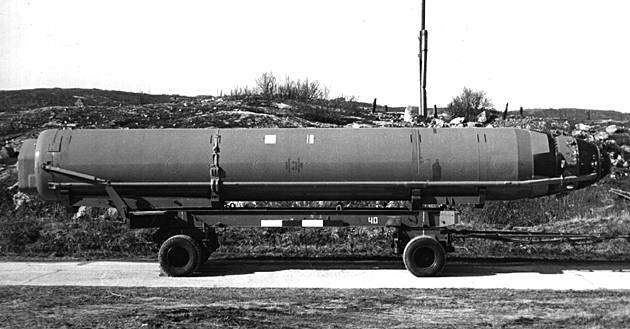
Rocket Р-29Р on a shipping trolley. Photo Russianarms.ru
At this stage, the submarine weapons system received an updated designation with the letter "P" instead of the previously used "M". The task of the D-9Р / Р-29Р project was to create a ballistic missile capable of carrying a divided warhead with several warheads, although the use of a monoblock one was not excluded. The technical assignment meant equipping the rocket with one, three or seven warheads. At the same time, the introduction of a number of new technical solutions was canceled due to their complexity. The P-29P product should have been an upgrade option for the P-29 being developed with the minimum amount of improvements required.
By the end of 1972, the design bureau has completed preliminary design and submitted documentation to industry leaders. The offer of specialists arranged for the customer, which resulted in an order to start the full development of a new complex. The corresponding decree of the USSR Council of Ministers issued 13 February 1973 of the year.
In the new project it was proposed to maximize the use of developments in previous developments. It was planned to unify the P-29 and P-29Р missiles for various units, and also to use the existing control systems for carrier submarines with minimal changes. This approach allowed to reduce the time required for the design, and also made it possible to speed up the tests and subsequent adoption. In particular, it was decided to abandon the test with a submerged stand, as well as to reduce the test program at the landfill. Also, due to the complexity, they temporarily abandoned the development of a warhead with seven warheads - it was planned to be created later.
A new ballistic missile, in order to save time and money, was to become a modernized version of the existing one. As a result of this approach, the overall architecture of the product, the layout of the aggregates, the design of most of its elements, etc. have been preserved. So, it was proposed to build the P-29P rocket according to a two-stage scheme with a homing stage and equip with liquid engines. The main unit of the rocket was an all-welded body, made of aluminum-magnesium wafer shells. Separation of the steps was proposed to produce using an elongated charge, tearing the body in the desired plane.
Most of the volume of the hull, as before, was given to the placement of tanks of two stages. The lower bottoms of tanks for fuel of both stages had a special concave shape, thanks to which engines could be placed in them. Also provided for curved upper bottoms, designed to accommodate certain units. The fuel tank was separated from the oxidizer tank using a double common bottom. Such a design allowed to exclude compartments between tanks and steps.
The first stage of the P-29P rocket was obtained by a liquid engine of the 3D40 type, using asymmetric dimethyl hydrazine and nitrogen tetroxide. This engine had one large marching chamber and two small helmsmen installed on cardan suspensions. The second stage received a single-chamber liquid engine 3D41. His only camera, mounted on a swinging gimbal, was responsible for creating traction and maneuvering.
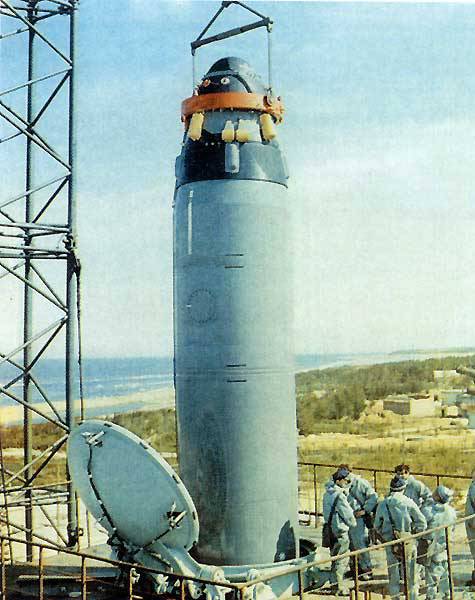
Loading an experienced rocket into the launcher at the land test site. Photo Rbase.new-factoria.ru
To the top of the second stage, it was proposed to mount the combat stage with control systems and payload in the form of warheads. The combat stage got its own liquid engine for maneuvering. In addition, it was equipped with an instrument compartment to accommodate all the necessary equipment. The instrument compartment was divided into two parts using a hermetic bottom. At the head of the compartment, equipped with a transparent fairing, a gyrostabilized platform with an astrovising device was placed. Other control system was mounted in the tail compartment of the compartment. For a more dense layout of units, the elements of the control system did not receive their own shock absorbers. Instead, the frame with the equipment as a whole was suspended on shock absorbers.
The design of the combat stage was calculated taking into account the use of various combat loads. This product could be used to carry any configuration of warheads required technical task. From one to seven warheads of various sizes with differing characteristics could be mounted on a combat stage. Provided service and replacement of the combat stage without removing the entire rocket from the launcher.
As in the P-29 project, it was proposed to use a combined guidance system based on inertial equipment and astrocorrection. During the passage of the active site and on the breeding site, the inertial navigation system was to follow the position of the rocket. After the separation of the first stage, an astrocorrection session was to be performed, specifying the location of the rocket and adjusting the trajectory. After this, the control again passed to the inertial instruments.
On the attachments of the combat stage there should have been several combat units, the number of which was determined by the customer of the product. The first version of the project envisaged the use of monoblock warheads with 450 CT. Instead of one combat unit, it was possible to use three 200 CT units each. Later 100-kt small-sized warhead was created. The rocket could carry seven such items. In addition to warheads, the rocket could be equipped with false targets for breaking through the enemy’s missile defense system.
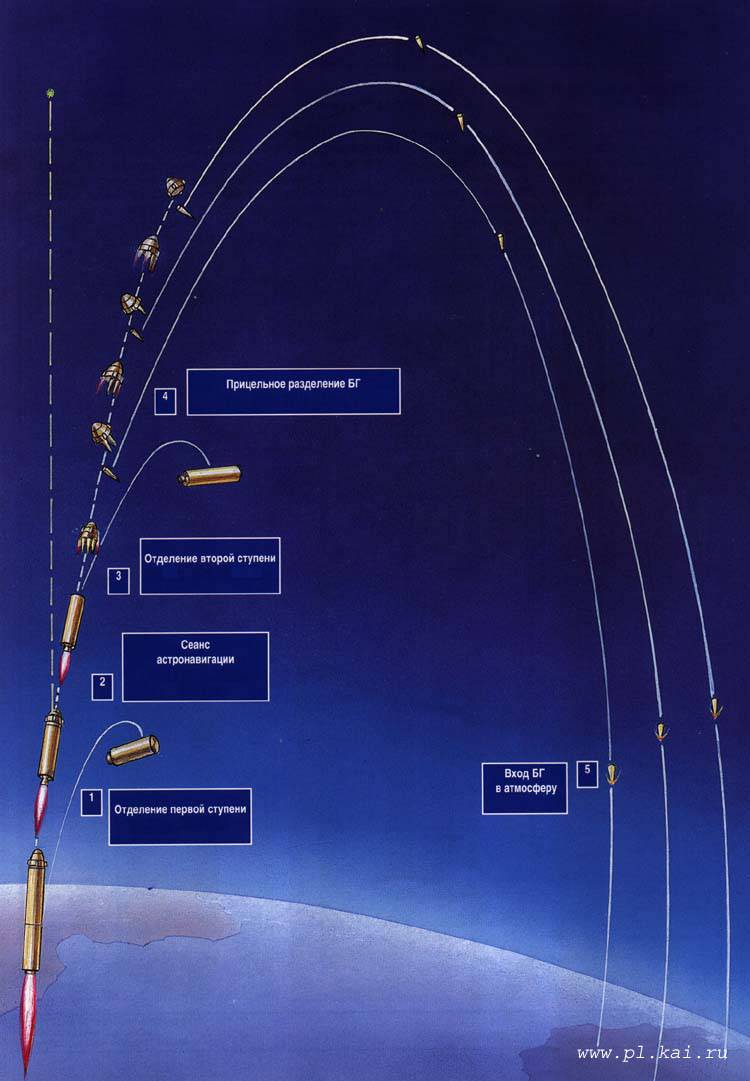
The flight pattern of the P-29P rocket with three warheads. Figure Rbase.new-factoria.ru
Regardless of the configuration of the warhead, the P-29P rocket was supposed to maintain overall dimensions and weight. The length of the product was 14,1 m, case diameter - 1,8 m. The launch weight was determined in 35,3 t. The combat units with different numbers of warheads differed in weight, which affected the main characteristics of the missile, first of all, range. So, when using a monoblock warhead, it was possible to attack targets at ranges up to 8000 km. The use of a split head reduced the maximum range to 6500 km. Regardless of the range, the QUO was 900 m.
During the D-9P / P-29P project, it was decided to save the majority of the aggregates for the submarine carrier. In addition, the basic principles of interaction between the launcher and the rocket were retained. The product was proposed to be delivered to the fleet in a filled ampoule, which made it possible to reduce the necessary preparation of the rocket before loading onto the carrier and before launching. After loading into the launcher, the rocket had to be held in place with several belts with shock absorbing devices. The equipment for controlling the missile system has undergone some changes, primarily related to the need to calculate the flight mission to defeat several targets.
The principles of launching a new rocket remained the same. It was allowed to start from the surface position of the carrier or from under the water, from a depth of up to several tens of meters. Due to the low-propulsion propulsion engine, the rocket had to go out of the mine, rise above the water and then increase the thrust, starting the active part of the flight. When using a monoblock warhead, the P-29P rocket flight was no different from the P-29. In the case of three or seven warheads, a breeding area was added to the flight path. After the second stage was disconnected, the combat stage was to perform maneuvering and consistently withdraw warheads to the required trajectories. The characteristics of the combat stage made it possible to hit several targets within a relatively large area.
The widespread use of existing and waste components and assemblies has reduced the testing of the new missile, eliminating the test on the submerged stand. In November 1976, the first P-29Ps were delivered to the Nenox site for testing on ground-based launchers. Almost two years before October 78, 18 launches were performed at the test site. In this case, one of the missiles fired at a distance close to the maximum. Other launches were made at a reduced range. 11 rockets with a monoblock warhead and 8 with missiles were expended.
In 1972, TsKB-18 was assigned the task of creating a project to modernize a nuclear submarine of the type 667BD "Murena-M", involving the use of the new D-9Р missile system. The new project received the designation "667БДР" and the cipher "Kalmar". The new submarine was to receive the 16 mine launchers for the P-29Р missiles and a set of appropriate control systems. Project development was completed by the beginning of 1974. 7 on May 74, the heading of the headboard of the K-441 project took place. It was also decided to abandon the completion of the submarine K-424 on the original project 667BD. The submarine, laid in January 1974, now had to finish building on the project "Kalmar". 30 December 1976, both of these submarines were handed over to the fleet. In addition, the cruiser K-449, laid out in November of the 1975, began service with them.
Shortly before joining the Navy, in November 1976 of the year, the submarine K-441 joined the testing of the new missile system. Test launches of the P-29P missiles from the submarine board were carried out until the autumn of the 78. During this time, 22 missile launches were performed in different configurations with different flight missions. According to reports, four missiles with monoblock warheads were used, six with three warheads each, and in the rest seven missiles were used. Started at the minimum, intermediate and maximum range. In addition, shooting was carried out in one gulp.
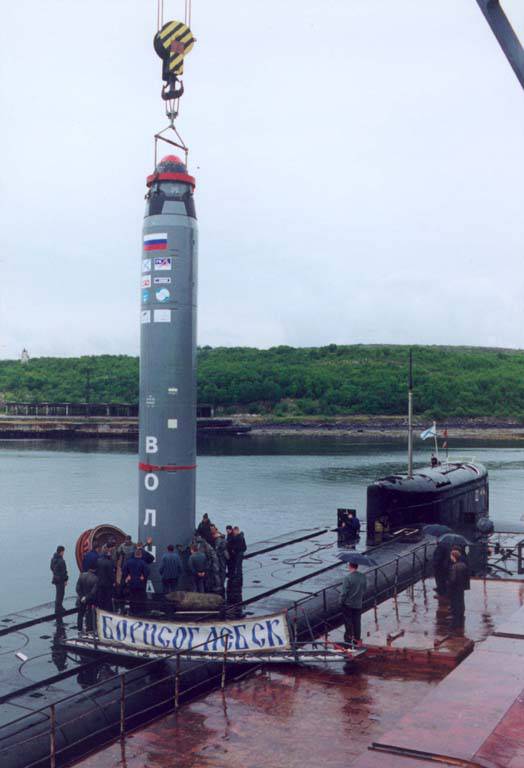
Loading of the P-29P rocket into the mine of the Borisoglebsk K-496 submarine (written off in 2009). Warfare.be Photo
The successful implementation of test launches opened the way for the fleet to use the new D-9Р complex with the P-29Р rocket. Before the end of the flight test, 25 August 1977, the new system was adopted as weapons submarine project 667BDR "Kalmar". In connection with the completion of the project of the missile complex, the construction of submarine carriers was continued. Until 1981, the Soviet Navy received 14 nuclear submarines of a new project, each of which could carry the X-NUMX P-16P missiles.
According to some reports, the development of the rocket with seven warheads was delayed, because of which it was put into service only in July 1979 of the year. It is also mentioned that this version of the rocket received its own designation P-29RL, and the complex as a whole was called D-9RL.
The appearance of the Kalmar type submarines and the P-29P missiles made it possible to significantly increase the strike potential of the submarine forces of the fleet. From the 1981 of the year, after the launch of the last boat of the new project, the fleet was able to keep up to the 224 Р-29Р missiles with intercontinental range. Depending on the combat equipment, submarine missiles could carry from 224 to 1568 combat units (from 16 to 112 on each submarine) and attack the corresponding number of enemy targets. Thus, the nuclear submarines of the 667BDR project and the P-29P missiles became the most important means of ensuring nuclear parity with a likely adversary.
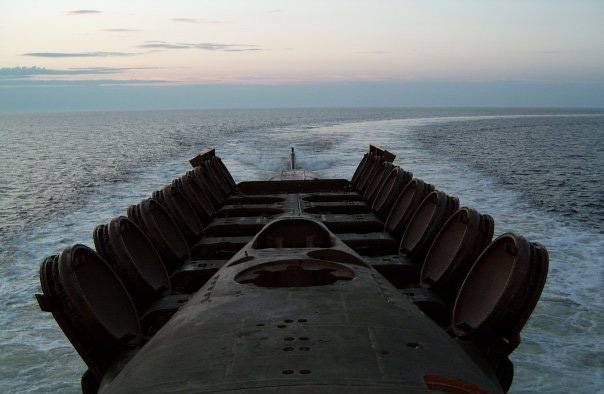
Launchers of submarines K-433 pr 667BDR. Photo of Wikimedia Commons
In 1980, it was decided to continue the development of the D-9Р / Р-29Р complex with an increase in its main characteristics. The first version of the update was the D-9РК complex with the P-29РК rocket. A new project was proposed to equip the rocket P-29Р with combat units borrowed from the D-19 / P-39 complex. This allowed, with similar weight parameters, to increase the power of charges up to 250 кт each. Due to some relief of the rocket, it was possible to increase the firing range by 5%, to increase the accuracy by 40%, and also by 43% to increase the diameter of the warhead breeding zone. In 1981, the tests of the new complex with the shooting of X-NUMX P-12РК missiles were carried out. In September, the X-NUMX complex D-29РК was adopted.
The next upgrade, carried out in 1984-85, also touched on improving the combat qualities of the rocket. The new product Р-29РКУ was proposed to be equipped with small-sized warheads with 100 kt power, designed for the new rocket Р-29РМ. Also, changes were made to control systems and shipboard equipment. After eight test launches in 1987, the D-9RKU / P-29RKU complex was put into service.
In March, the 1990 of the year adopted the R-29РКУ-01 rocket with warheads with a power of 20 кТ, also borrowed from the Р-29РМ product. There is information about the creation of the P-29RKU-02 modification with the next upgrade of combat equipment. Such a rocket was put into service in the 2006 year.
In the mid-nineties, the State Rocket Center. V.P. On the basis of the P-29P product, Makeev developed the Wave launch vehicle. Such a rocket retained two stages of the existing structure, but received a new third stage. The latter was equipped with a solid-fuel engine and was designed to remove the load on the desired trajectory. The maximum payload of the Wave was defined in 115 kg. In 1995-2005, five launches of such launch vehicles with different loads on board took place, three of which resulted in the successful implementation of the assigned tasks.
In 1979, the most large-scale modernization of the D-9Р / Р-29Р complex began, the result of which was the creation of the R-29РМ rocket. Updating the rocket led to a significant increase in performance, and also required the development of a new submarine carrier. Within the framework of the new project, a significant increase in performance was achieved, thanks to which, in particular, the P-29РМ family missiles still remain in service and remain an essential element of the Russian strategic nuclear forces.
Due to the problems of the nineties, as well as obsolescence and physical obsolescence, most of the nuclear submarines of the 667BDR Kalmar Project have been written off and disposed of. At the moment, only three boats of this type remain in service: K-433 "St. George the Victorious", K-223 "Podolsk" and K-44 "Ryazan". All three strategic submarine missile cruisers serve as part of the Pacific Fleet. At the beginning of the last decade, the K-129 “Orenburg” submarine was upgraded according to the 09786 project, as a result of which it became the carrier of a special underwater vehicle, and also received a new BS-136 tail number.
Over time, the Kalmar submarines were supplanted by the newer submarines of the 667BDRM Dolphin project, armed with the R-29РМ missiles. Nevertheless, a certain number of such ships still remain in the fleet and serves, ensuring the security of the country. The appearance of the D-9Р / Р-29Р rocket complex made it possible in a short time to ensure the required parity with the likely adversary in terms of the number of deployed warheads. After almost four decades that have passed since the moment they were put into service, these systems are still operated by the fleet and solve assigned tasks, despite their moral and physical obsolescence. It can be assumed that the “Squids” with the P-29Р family of rockets will remain in operation for the next several years, being used in parallel with submarines and missile complexes of new types.
Based on:
http://rbase.new-factoria.ru/
http://makeyev.ru/
http://russianarms.ru/
http://deepstorm.ru/
http://bastion-karpenko.ru/
http://arms.ru/
Apalkov Yu.V. Submarines of the Soviet Navy 1945-1991 Volume II: - M: Morkniga, 2011
Shirokorad A.B. Weapons of the domestic fleet. 1945-2000. - Minsk: “Harvest”, 2001
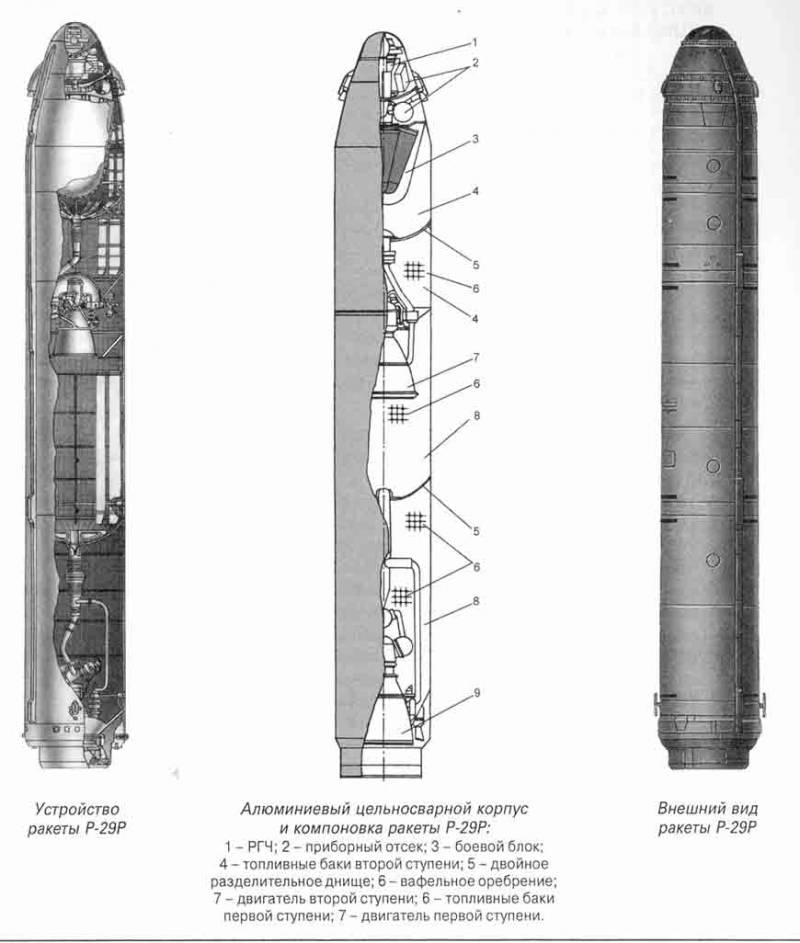

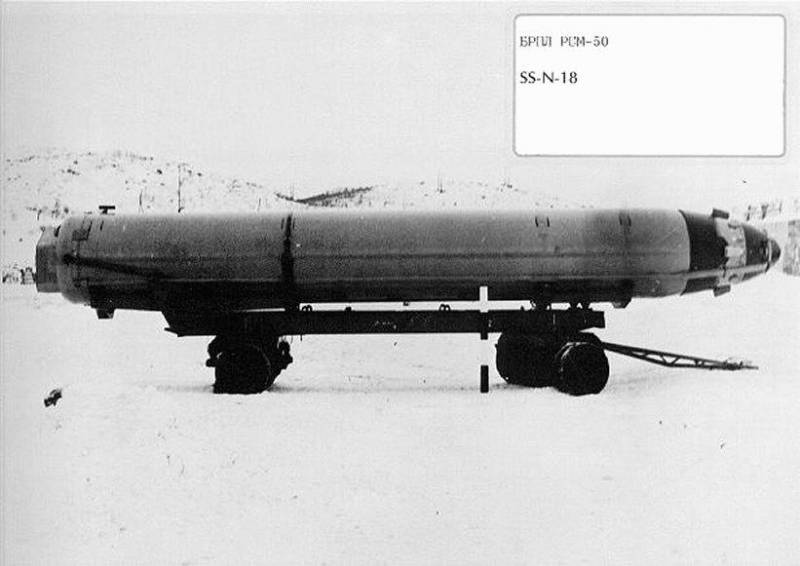
Information